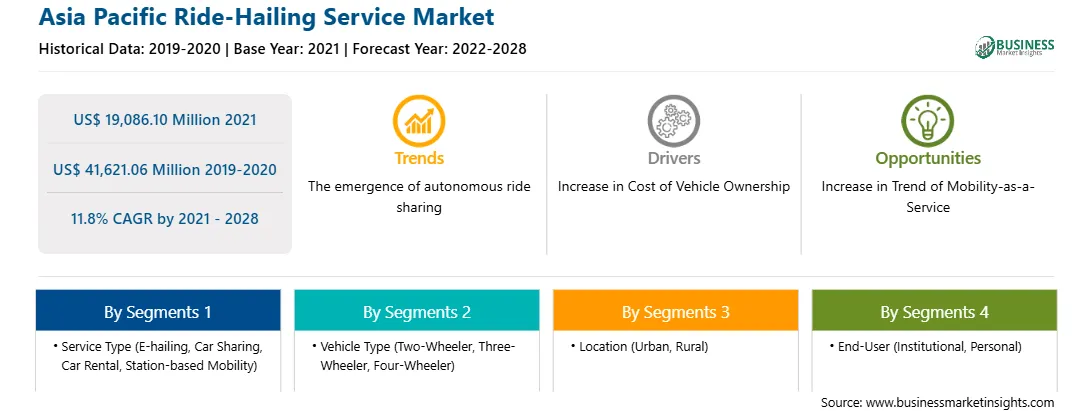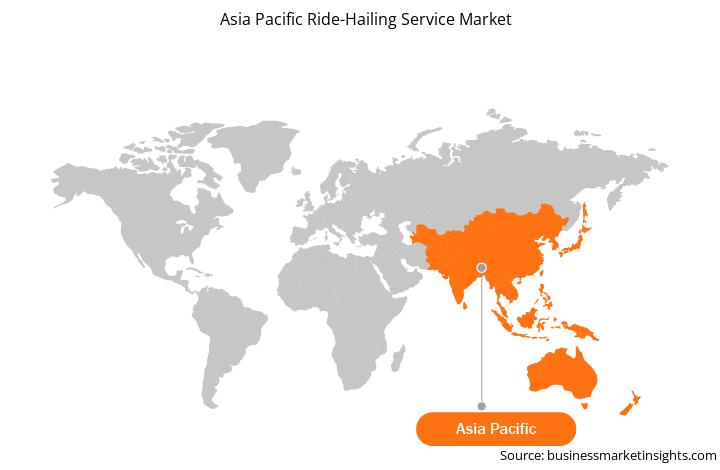Market Introduction
The ride-hailing service market in Asia Pacific is further segmented into China, India, Japan, Australia, and South Korea. The region constitutes world’s Top 2 most populated countries—India and China. It is also characterized by significant developments in infrastructure and increase in purchasing power of the individuals in the region. Further, the rising number of individuals migrating toward popular cities for better employment opportunities is also anticipated to propel the demand for ride-hailing services in big cities in the region. Subsequently, owing to the fact that 60% of world population is resident in the region, the ride hailing market is large in the region and is growing with high rate. The growing use of smartphones, development of wireless infrastructure backed by the presence of 4G services and with the advancements in information and communication technology (ICT), traditional services have been upgraded to provide a wide variety of real-time and demand-responsive trips. Service providers such as Uber, Ola, Grab, and Rapido, amongst others, have provided a smartphone-based platform to link riders with community drivers. Further, the per capita income in most of Asia Pacific countries is lower than in Western countries, Asia Pacific countries has a much lower number of vehicles per 1,000 people. Hence, convenience of commuting in congested traffic and reduced fares have been the primary drivers of ride-hailing service market's growth, which is expected to continue in the coming years. Further, factors such as an increase in the daily commute to work in urban areas and a strong propensity to save fuel by providing a ride to commuters and colleagues travelling the same route are expected to fuel the Asia Pacific ride-hailing service market.
In Asia Pacific, India is the worst-hit country by the COVID-19 outbreak. Asia Pacific experienced a notable decline in several economic activities as the government authorities imposed strict lockdowns, travel bans, and business shutdown. Many countries in Asia are in a developing state. Owing to layoffs and salary cuts, buying capacity of majority of consumers was affected drastically. Expenditure on nonessentials was avoided as much as possible. This has resulted in weak demand for ride-hailing services in the region. The COVID-19 pandemic has not only disrupted the overall economy and automobile market in Asia Pacific but has also changed the buyers’ attitude toward the sector. According to the Organization for Economic Co-operation and Development (OECD), the pandemic has affected major economies of the region, including China, India, South Korea, and Vietnam and this market has experienced a downward industrial growth during the first two quarter of 2020. China dominates the global manufacturing sector with significantly unparalleled, large numbers of manufacturing units, and it is considered to have the largest production sector globally. The COVID-19 emergence and imposition of lockdown across the country have substantially disrupted its manufacturing sector, thereby restricting the ride-hailing industry. Further, India is also considered to have a substantial number of manufacturing facilities, and a large and noteworthy ride-hailing industry. It is presently the worst hit country in Asia Pacific. Since the emergence of the COVID-19 virus, the country has undergone several lockdown phases, which has adversely affected ride-hailing services. Difficulties in gathering necessary funding would further impact the market growth. However, China’s transition toward a high-tech market, flexibility in the Japanese manufacturing sector, and adequate government support and business strategies in India are among the key factors that would contribute to a rapid recover of Asia Pacific from the tremors of the pandemic.
Market Overview and Dynamics
The ride-hailing service market in Asia Pacific is expected to grow US$ 19,086.10 million in 2021 to US$ 41,621.06 million by 2028; it is estimated to grow at a CAGR of 11.8% from 2021 to 2028. Taxis, passenger vehicles, and charter cars are examples of on-demand services, which provide real-time feedback, vehicle tracking, and rating for service experience providing to end clients. Ride-hailing services ensure that clients can reliably identify vehicles and track their journeys while also providing safety to the occupants, which is projected to boost market expansion significantly. Abundant availability of cars and comparison of fare with correspondents facilitated by many mobile applications further drive the growth of the market. For instance, Migo, a Seattle-based search engine for on-demand ride services, launched a smartphone application in August 2017 that allowed users to compare the locations and rates of nearby taxis, car-sharing, and ride-hailing providers on a single platform. Furthermore, artificial intelligence (AI) is used to efficiently coordinate and operate on-demand transportation systems. It provides passengers with traffic-related information in order to improve driver cooperation. As a result, the market has a more favorable outlook. Increased tourism activities throughout the world, an increase in the working-class population, a rising trend of road trips, and modernization in the automobile sector are all expected to fuel ride-hailing service market expansion.
Key Market Segments
In terms of service type, the E-hailing segment accounted for the largest share of the Asia Pacific ride-hailing service market in 2020. In terms of vehicle type, the four-wheeler segment accounted for the largest share of the Asia Pacific ride-hailing service market in 2020. In terms of location, the urban segment accounted for the largest share of the Asia Pacific ride-hailing service market in 2020. In term of end-user, institutional segment held a larger market share of the ride-hailing service market in 2020.
Major Sources and Companies Listed
A few major primary and secondary sources referred to for preparing this report on the ride-hailing service market in Asia Pacific are company websites, annual reports, financial reports, national government documents, and statistical database, among others. Major companies listed in the report are Daimler AG; Delphi Technologies Plc.; Uber Technologies Inc.; Didi Global Inc.; Gett; ANI Technologies Pvt. Ltd.; and Grab Holdings Inc. among others.
Reasons to buy report
Asia Pacific Ride-Hailing Service Market Segmentation
Asia Pacific Ride-Hailing Service Market – By Service Type
Asia Pacific Ride-Hailing Service Market – By
Vehicle Type
Asia Pacific Ride-Hailing Service Market – By Location
Asia Pacific Ride-Hailing Service Market – By End-User
Asia Pacific Ride-Hailing Service Market – By
Country
Asia Pacific Ride-Hailing Service Market – Companies Mentioned
Strategic insights for the Asia Pacific Ride-Hailing Service provides data-driven analysis of the industry landscape, including current trends, key players, and regional nuances. These insights offer actionable recommendations, enabling readers to differentiate themselves from competitors by identifying untapped segments or developing unique value propositions. Leveraging data analytics, these insights help industry players anticipate the market shifts, whether investors, manufacturers, or other stakeholders. A future-oriented perspective is essential, helping stakeholders anticipate market shifts and position themselves for long-term success in this dynamic region. Ultimately, effective strategic insights empower readers to make informed decisions that drive profitability and achieve their business objectives within the market.

| Report Attribute | Details |
|---|---|
| Market size in 2021 | US$ 19,086.10 Million |
| Market Size by 2028 | US$ 41,621.06 Million |
| Global CAGR (2021 - 2028) | 11.8% |
| Historical Data | 2019-2020 |
| Forecast period | 2022-2028 |
| Segments Covered |
By Service Type
|
| Regions and Countries Covered | Asia-Pacific
|
| Market leaders and key company profiles |
The geographic scope of the Asia Pacific Ride-Hailing Service refers to the specific areas in which a business operates and competes. Understanding local distinctions, such as diverse consumer preferences (e.g., demand for specific plug types or battery backup durations), varying economic conditions, and regulatory environments, is crucial for tailoring strategies to specific markets. Businesses can expand their reach by identifying underserved areas or adapting their offerings to meet local demands. A clear market focus allows for more effective resource allocation, targeted marketing campaigns, and better positioning against local competitors, ultimately driving growth in those targeted areas.

The Asia Pacific Ride-Hailing Service Market is valued at US$ 19,086.10 Million in 2021, it is projected to reach US$ 41,621.06 Million by 2028.
As per our report Asia Pacific Ride-Hailing Service Market, the market size is valued at US$ 19,086.10 Million in 2021, projecting it to reach US$ 41,621.06 Million by 2028. This translates to a CAGR of approximately 11.8% during the forecast period.
The Asia Pacific Ride-Hailing Service Market report typically cover these key segments-
The historic period, base year, and forecast period can vary slightly depending on the specific market research report. However, for the Asia Pacific Ride-Hailing Service Market report:
The Asia Pacific Ride-Hailing Service Market is populated by several key players, each contributing to its growth and innovation. Some of the major players include:
The Asia Pacific Ride-Hailing Service Market report is valuable for diverse stakeholders, including:
Essentially, anyone involved in or considering involvement in the Asia Pacific Ride-Hailing Service Market value chain can benefit from the information contained in a comprehensive market report.